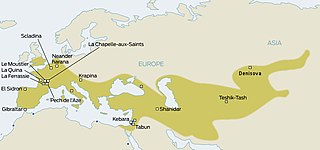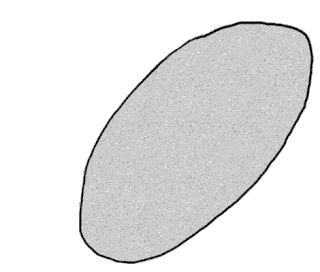
In archaeology, a hammerstone is a hard cobble used to strike off lithic flakes from a lump of tool stone during the process of lithic reduction. The hammerstone is a rather universal stone tool which appeared early in most regions of the world including Europe, India and North America. This technology was of major importance to prehistoric cultures before the age of metalworking.

In archaeology, a lithic flake is a "portion of rock removed from an objective piece by percussion or pressure," and may also be referred to as simply a flake, or collectively as debitage. The objective piece, or the rock being reduced by the removal of flakes, is known as a core. Once the proper tool stone has been selected, a percussor or pressure flaker is used to direct a sharp blow, or apply sufficient force, respectively, to the surface of the stone, often on the edge of the piece. The energy of this blow propagates through the material, often producing a Hertzian cone of force which causes the rock to fracture in a controllable fashion. Since cores are often struck on an edge with a suitable angle (<90°) for flake propagation, the result is that only a portion of the Hertzian cone is created. The process continues as the flintknapper detaches the desired number of flakes from the core, which is marked with the negative scars of these removals. The surface area of the core which received the blows necessary for detaching the flakes is referred to as the striking platform.
A stone tool is, in the most general sense, any tool made either partially or entirely out of stone. Although stone tool-dependent societies and cultures still exist today, most stone tools are associated with prehistoric cultures that have become extinct. Archaeologists often study such prehistoric societies, and refer to the study of stone tools as lithic analysis. Ethnoarchaeology has been a valuable research field in order to further the understanding and cultural implications of stone tool use and manufacture.

In the field of lithic reduction, a burin is a type of handheld lithic flake with a chisel-like edge which prehistoric humans used for engraving or for carving wood or bone.

The Mousterian is an archaeological industry of stone tools, associated primarily with the Neanderthals in Europe, and to the earliest anatomically modern humans in North Africa and West Asia. The Mousterian largely defines the latter part of the Middle Paleolithic, the middle of the West Eurasian Old Stone Age. It lasted roughly from 160,000 to 40,000 BP. If its predecessor, known as Levallois or Levallois-Mousterian, is included, the range is extended to as early as c. 300,000–200,000 BP. The main following period is the Aurignacian of Homo sapiens.

The Bayankhongor Province or Bayanhongor Aimag is one of the 21 aimags (provinces) of Mongolia. It is located in the southwest of the country and, at 116,000 square kilometers, it is one of the largest aimags. The capital of the aimag shares the provincial name, Bayankhongor.

The Levallois technique is a name given by archaeologists to a distinctive type of stone knapping developed around 250,000 to 300,000 years ago during the Middle Palaeolithic period. It is part of the Mousterian stone tool industry, and was used by the Neanderthals in Europe and by modern humans in other regions such as the Levant.

The prepared-core technique is a means of producing stone tools by first preparing common stone cores into shapes that lend themselves to knapping off flakes that closely resemble the desired tool and require only minor touch-ups to be usable.
Bayangovi is a sum (district) of Bayankhongor Province in south-eastern Mongolia. It is situated approximately 40 kilometres south of the lake Orog Nuur, 170 km from provincial capital Bayankhongor and 650 km south-west of Ulaanbaatar. Bayangovi is surrounded by the Ikhee Bogd mountain range, and by desert.

The Tabun Cave is an excavated site located at Nahal Me'arot Nature Reserve, Israel and is one of the Human Evolution sites at Mount Carmel, which were proclaimed as having universal value by UNESCO in 2012.

The Later Stone Age (LSA) is a period in African prehistory that follows the Middle Stone Age.
Riwat is a Paleolithic site in Punjab, northern Pakistan. Another site, called Riwat Site 55, shows a later occupation dated to around 45,000 years ago.

Kozarnika or Peshtera Kozarnika is a cave in northwestern Bulgaria that was used as a hunters’ shelter as early as the Lower Paleolithic. It marks an older route of early human migration from Africa to Europe via the Balkans, prior to the other currently suggested route - the one across Gibraltar. The cave probably keeps the earliest evidence of human symbolic behaviour and the earliest European Gravette flint assemblages came to light here.
John W. Olsen is an American archaeologist and paleoanthropologist specializing in the early Stone Age prehistory and Pleistocene paleoecology of eastern Eurasia. Olsen is Regents' Professor Emeritus of Anthropology and Executive Director of the Je Tsongkhapa Endowment for Central and Inner Asian Archaeology at the University of Arizona in Tucson, Arizona, USA. He is also a Leading Scientific Researcher at the Institute of Archaeology and Ethnography of the Russian Academy of Sciences' Siberian Branch in Novosibirsk and Guest Research Fellow at the Chinese Academy of Sciences' Institute of Vertebrate Paleontology and Paleoanthropology (IVPP) in Beijing where he is also Co-Director of the Zhoukoudian International Paleoanthropological Research Center. Olsen has been named a Distinguished Researcher of the Nihewan Research Center in Hebei Province, China. He is also a Foreign Expert affiliated with The Yak Museum in Lhasa, Tibet.
Minori Cave is part of the Callao limestone formation, located in Barangay Quibal, Municipality of Peñablanca, Cagayan Province in Northern Luzon. The said cave has two openings. One, designated as Mouth B, is located at 17° 43' 17" N latitude and 121° 49' 42" E longitude. The other opening, Mouth A is located 17° 43' 21" N latitude and 121° 49' 44" E longitude. The cave has an average elevation of about 200 m (656.2 ft) above sea level, and length and width of 147 m (482.3 ft) and 7 to 11 m, respectively. The cave is divided into four chambers with mouth A as chamber A and mouth B as chamber D. Chambers B and C are in between the two mouths.
The Obi-Rakhmat Grotto is a Middle Paleolithic prehistoric site that yielded Neanderthal fossils. It is a shallow karst cave near the junction of the Chatkal and Pskem Rivers at the southwestern end of the Talassky Alatau Range in the Tien Shan Mountains, 100 km (62 mi) northeast of Tashkent, Uzbekistan.

Okladnikov Cave is a paleoanthropological site located in the foothills of the Altai Mountains in Soloneshensky District, Altai Krai in southern Siberia, Russia. The cave faces south and is located on a Devonian karst escarpment, lying about 14 metres (46 ft) above the left bank of the Sibiryachikha River valley below; the river itself is a tributary of the Anuy River.
The Ahmarian culture was a Paleolithic archeological industry in the Levant dated at 46,000–42,000 BP and thought to be related to Levantine Emiran and younger European Aurignacian cultures.

Fumane Cave is a dolomite cave in the Fumane Valley, which was formed in the Neogene period. The cave contains rich evidence of three prehistoric hominid cultures: Mousterian, Uluzzian and Aurignacian. Additionally, the cave has some of the oldest cave art that has been discovered in Europe.

Tongtiandong is an archaeological site in the Xinjiang Autonomous Region of China, just to the south of the Altai mountains. The site had hunter-foraging human activity circa 40,000 BP.













